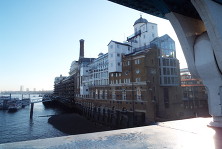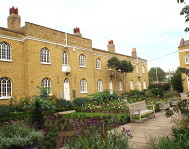






 Search
Search

Dulwich Park
“Dulwich is certainly a delightful suburb ; all the year round the thrush charms us with her song, and the fine old houses with their grounds cluster round the park with a repetition of its beauties on a smaller scale. It is particularly free from the loafing population, which lolls upon the grass in St. James's Park thick as windfalls in an orchard. Though open to all, it is specially frequented by a superior class of visitors from the immediate neighbourhood; but now that the park is becoming better known, the circle has been extended, and on Sundays especially, Dulwich is blocked with vehicles and omnibuses plying from various parts.”
J J Sexby (first Superintendent of London County Council Parks Department)
Municipal Parks, Gardens and Open Spaces of London (1905)
During the second half of the 19th century, there was a growing awareness that open spaces were necessary for the health and well being for those living in overcrowded and often insanitary conditions in parts of London. Large municipal parks had been created in densely populated areas (Southwark Park had been opened in 1869) and common land purchased by local vestries to ensure they remained as open spaces for use by the public rather than being built upon (Peckham Rye Common was purchased by Camberwell Vestry in 1868). The Metropolitan Public Gardens Association was formed in 1882 to create parks and open spaces, often from former graveyards, within built up areas.
The creation of Dulwich Park which opened in 1890 was unusual in that it was created in what was then a semi-rural location, in a middle class area where most residents lived in comparatively large houses with their own gardens. As Mrs Evelyn Cecil wrote in her book London Parks and Gardens, it was not surprising that plants thrived in the park “as it is not in a crowded, smoky district, but in one of the most favoured of suburbs. Dulwich Park adds greatly to the advantages of the neighbourhood.”
In the 1880s, Dulwich was mostly farmland. Houses had been built along the High Street, now called Dulwich Village, and along Dulwich Common to the South, and there were various individual, large detached houses. Though building in East Dulwich was well advanced, Dulwich College showed reticence in using their land for house building, and had recently sold part of their land for the building of the railway which paid for the construction of the new Dulwich College building.
Dulwich College first approached the Metropolitan Board of Works regarding a new park through its surveyor, Charles Barry, in 1884, two years after the running of the Estates had, by Act of Parliament, become separate from the provision of education. The College desired to set aside a part of their estate as an open space for use by the public for ever and offered to make over 72 acres to the Metropolitan Board of Works provided the Board obtained from Parliament an Act enabling them to do so and then undertook to maintain the new park. This Act was passed the following year. The land Dulwich College made over to the MBW was estimated at £1,000 per acre and their gift was undoubtedly generous. The land, referred to as Five Fields, comprised gently undulating meadows which facilitated the task of laying out a new park.
Work on laying out the park was delayed while interests of tenants and occupiers of the land were acquired. It was also necessary to apply to Parliament for powers to stop up certain public and private ways across the lands to prevent the public going into the park during the late hours of the night.
Lieut J J Sexby was in overall charge of the design and landscaping of the new park and based his design on plans drawn up by Charles Barry that included the wide curving carriageway built around the perimeter. By February 1890 it was reported that the planting was progressing rapidly. All around the borders of the newly made drives a mixture of ornamental and what were referred to as “forest “ trees – ash, lime, plane, chestnut, beech, birch, oak, sycamore and elm – were planted 14 yards apart which complemented the already well established oak trees, some of which still survive today. A lake with water cascade, shelters and two lodges were built, and large areas set aside for playing cricket and tennis which Sexby described in 1905 as being “crammed” on Saturday afternoons. An aviary was installed which was still there until at least the 1980s and a large refreshment house.
An American Garden was laid out and Sexby described the “gorgeous masses of blooms” of the rhododendrons and azaleas which today, over a hundred years later, are probably even more spectacular. Queen Mary delighted in visiting in May when the American Garden was in full bloom and one of the park gates was renamed in her honour in 1954 having previously been called Dulwich Common Gate. Another gate and the lodge adjacent to it is named after Lord Rosebery, first Chairman of the London County Council (this had superseded the Metropolitan Board of Works in 1889) who had opened the park in June 1890
College Lodge, one of two lodges, used to house the Park Superintendent and is now used for various activities.
The Act of Parliament that enabled the MBW to take over the land also forbade music and public meetings within the park. This explains the lack of a bandstand when most parks laid out at this time had one, and the latter restriction, according to Sexby, resulted in “keeping out the noisy element”. When Dulwich College began building houses in newly laid out streets that included Turney Road, Burbage Road and Court Lane at the end of the 19th century and the early 20th century, the proximity to an attractive, publicly maintained park would have increased their desirability and have been beneficial to property prices. Though the park was open to the general public, it maintained an air of exclusivity. Mrs Cecil wrote in 1907 “it has not hitherto been crowded, and is by no means a playground of the poorest classes, but now the advent of electric trams and rapid communication may somewhat lessen its exclusiveness.” Accessibility became easier as bus transport improved in the first half of the 20th century and car ownership became more common in the latter half.
Today, though the basic layout of the park has been maintained, there are many activities that would confound the Victorians. Still popular for sports, there are fun runs and park runs, a fun fair, a festival fair during Dulwich Festival, film screenings and various events held in College and Rosebery Lodges. There are a set of three recently installed sculptures by Conrad Shawcross named the Perpetual Chord which replaced the sculpture Two Forms (Divided Circle) by Barbara Helpworth, installed in 1972 but stolen in 2011. And there is a mural by Stik, painted on the side of the bowling green clubhouse as part of the Dulwich Outdoor Gallery and inspired by the painting Three Boys by Murillo displayed in the Dulwich Picture Gallery.